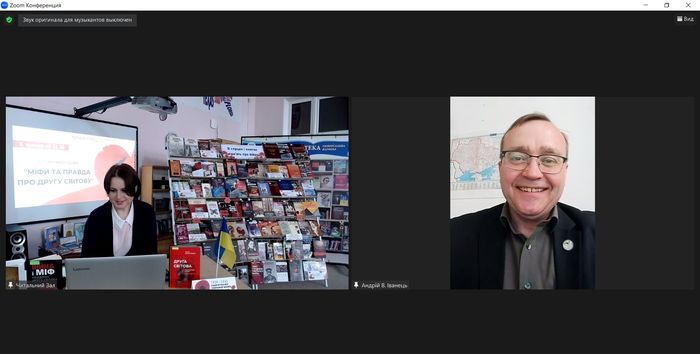An employee of the Holodomor Museum spoke about the genocides of the Nazi and communist regimes in the Crimea in 1941–1944
On May 8, the event dedicated to the Day of Remembrance and Reconciliation in the Khmelnytskyi Regional Universal Scientific Library on the topic “Myths and Truth about the Second World War” took place in a military atmosphere. A historian, a participant of the Orange Revolution and the Revolution of Dignity, and now the captain of the 19th Missile Brigade of the Armed Forces of Ukraine, Oleksii Nakonechny, and the leading researcher of the National Museum of the Holodomor-Genocide, candidate for historical sciences Andrii Ivanets, were going to speak before the young people gathered in the reading room.
O. Nakonechny revealed the contribution of Ukrainians to the victory over Nazism in the Second World War, told in which armies and on which fronts Ukrainians fought against Nazism; how much Ukraine suffered during the Second World War; when the victory over Nazism came; the courage of the Armed Forces of Ukraine in the modern realities of the full-scale war of Russia against Ukraine. However, the air alarm signal prevented the performance from being completed. The participants of the event had to move to the shelter.
The head of the library’s reading room, Lilia Semeniuk, and the employee of the Holodomor Museum, Andrii Ivanets, had to record a conversation about Crimea in the Second World War without the participation of young people for distribution among teachers and young people. In a concise form, the historian told about the military operations on the Crimean Peninsula in 1941-1944, which were marked by the extremely ineffective actions of the Soviet command in the first period of the German-Soviet war. Many soldiers and civilians paid with their lives, health, property and freedom for that.
Andrii Ivanets also spoke about the history of genocides and ethnic cleansing in Crimea, directed against a number of ethnic communities and peoples – Jews, Roma, Germans, Italians, Bulgarians, Armenians, Greeks, etc., which drastically reduced the number and changed the ethnic composition of the Crimean population. Particularly, he focused on the genocides of the smallest and largest indigenous peoples of Crimea and Ukraine – the Krymchaks, committed by the Nazis; and the Crimean Tatars committed by the communist regime centred in Moscow. In particular, the scholar said that the Krymchaks are called “the shot people”, because 70-80% of its representatives were destroyed by the Nazis in 1941-1944. And the Crimean Tatar people fell into the category not only of the deported peoples and ethnic communities of the USSR but also among the three longest-detained in places of deportation. In 2015, Ukraine recognized the deportation of the indigenous Crimean Tatar people as genocide, after which several other states qualified this crime as such.
An employee of the Holodomor Museum also spoke about the importance of Crimea for guaranteeing the security and development of the economy and culture of Ukraine at the current stage, about the moral obligation of the state and civil society to help the pro-Ukrainian Crimeans, the ethnic communities most discriminated against by the occupiers – the indigenous Crimean Tatar people and the community of Ukrainians in Crimea. Without the liberation of the south, there will not be a peaceful and prosperous Ukraine, as he believes.
